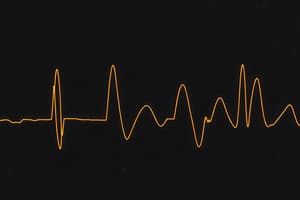Podcast
Questions and Answers
What does the event-related fMRI reveal about the attentional control network?
What does the event-related fMRI reveal about the attentional control network?
- It is not influenced by attentional directives.
- It is delineated by responses to both cues and stimuli. (correct)
- It activates only during stimulus processing.
- It is solely responsible for directing attention.
Which brain regions are primarily implicated in neglect?
Which brain regions are primarily implicated in neglect?
- Hippocampus and amygdala
- Temporoparietal junction, angular gyrus, and supramarginal gyrus (correct)
- Cerebellum and brainstem
- Frontal lobe and occipital lobe
What characterizes the areas of the brain involved in attentional control as revealed by the fMRI experiment?
What characterizes the areas of the brain involved in attentional control as revealed by the fMRI experiment?
- They are selectively active during cue presentation. (correct)
- They are activated solely by attentional cues.
- They become active only during stimulus presentation.
- Their function is independent of attention.
How does the response related to stimulus onset differ from that related to cue onset?
How does the response related to stimulus onset differ from that related to cue onset?
Which type of attention is primarily modulated by the areas activated during stimulus presentation?
Which type of attention is primarily modulated by the areas activated during stimulus presentation?
What does the delay between cue and stimulus indicate in attentional studies?
What does the delay between cue and stimulus indicate in attentional studies?
Which statement about different forms of neglect is accurate?
Which statement about different forms of neglect is accurate?
What role does the attention-directing cue play in the attentional control network?
What role does the attention-directing cue play in the attentional control network?
What does feature-based attention primarily refer to?
What does feature-based attention primarily refer to?
How does object-based attention enhance processing?
How does object-based attention enhance processing?
What is the role of the attentional network in sensory processing?
What is the role of the attentional network in sensory processing?
Which statement accurately describes the neurological effects on attention?
Which statement accurately describes the neurological effects on attention?
What distinguishes midbrain attentional networks from cortical attentional networks?
What distinguishes midbrain attentional networks from cortical attentional networks?
What is the primary focus of the premotor theory of attention?
What is the primary focus of the premotor theory of attention?
Which of the following best describes object-based attention?
Which of the following best describes object-based attention?
Which of the following is a characteristic of feature-based attention?
Which of the following is a characteristic of feature-based attention?
What is indicated by more spikes per unit time in a neuron when its receptive field is covertly attended?
What is indicated by more spikes per unit time in a neuron when its receptive field is covertly attended?
Which area of the brain is specifically associated with motion attention?
Which area of the brain is specifically associated with motion attention?
How does attention affect activity in the visual cortex according to the findings?
How does attention affect activity in the visual cortex according to the findings?
What was the approximate latency of the attention effect after the onset of the moving or color arrays as indicated by MEG measures?
What was the approximate latency of the attention effect after the onset of the moving or color arrays as indicated by MEG measures?
What task were subjects asked to perform in the study described?
What task were subjects asked to perform in the study described?
Which area of the brain was modulated when color was attended?
Which area of the brain was modulated when color was attended?
What do the reddish yellow blobs in the MRI representation signify?
What do the reddish yellow blobs in the MRI representation signify?
What effect does object-based attention have on spatial attention?
What effect does object-based attention have on spatial attention?
What type of attention is focused on specific stimulus features regardless of their location?
What type of attention is focused on specific stimulus features regardless of their location?
In the study involving single-cell electrophysiology, what was primarily measured to assess visual attention?
In the study involving single-cell electrophysiology, what was primarily measured to assess visual attention?
What is the primary focus of object-based attention?
What is the primary focus of object-based attention?
During the experiment, what was the purpose of the cue indicating the location for attention?
During the experiment, what was the purpose of the cue indicating the location for attention?
What was the role of the fixation point in the visual attention paradigm?
What was the role of the fixation point in the visual attention paradigm?
What occurs when attention is directed away from a neuron’s receptive field?
What occurs when attention is directed away from a neuron’s receptive field?
What type of attention is less likely to engage bonly focus on features of the stimulus?
What type of attention is less likely to engage bonly focus on features of the stimulus?
Which areas of the macaque monkeys’ brain were involved in the visual attention study?
Which areas of the macaque monkeys’ brain were involved in the visual attention study?
What is the primary function of attention in cognitive processing?
What is the primary function of attention in cognitive processing?
Which type of attention is characterized as transient, bottom-up, and automatic?
Which type of attention is characterized as transient, bottom-up, and automatic?
Which model of attention suggests that stimuli are filtered based on their importance before they reach conscious awareness?
Which model of attention suggests that stimuli are filtered based on their importance before they reach conscious awareness?
In feature-based attention, what does the process primarily focus on?
In feature-based attention, what does the process primarily focus on?
What is the main difference between spatial and object-based attention?
What is the main difference between spatial and object-based attention?
What role do attentional networks play in attention management?
What role do attentional networks play in attention management?
How does the cocktail party effect illustrate divided attention?
How does the cocktail party effect illustrate divided attention?
What is the primary distinction between endogenous and exogenous attention?
What is the primary distinction between endogenous and exogenous attention?
Flashcards are hidden until you start studying
Study Notes
Attentional Network Overview
- Event-related fMRI identifies the attentional control network through cues directing attention.
- A long delay between cue and stimulus helps delineate areas involved in attentional control and stimulus processing.
- Cue-related responses indicate attentional mechanisms; stimulus-related responses highlight processing regions.
Attentional Networks and Lesion Effects
- Major regions implicated in attentional neglect include the temporoparietal junction (TPJ) and angular gyrus.
- Different types of neglect correlate with dysfunctions in specific brain regions.
Types of Attention
- Voluntary eye movements can be classified into early and late selection processes.
- Feature-based attention allows for attendance to specific stimulus attributes (motion, color, shape), represented in distinct brain regions (e.g., motion in MT, color in V4).
- Object-based attention facilitates overall object processing, enhancing the processing of unattended parts of objects.
Influence on Sensory Processing
- Attention modulates activity in visual cortices; noticeable activity differences occur when attention is applied.
- High temporal resolution measures show that attentional effects emerge approximately 100 ms after stimuli onset.
Attentional Theories and Mechanisms
- Attention is essential for conscious perception, underpinning the cocktail party effect.
- Two main types of attention: exogenous (automatic, bottom-up) and endogenous (voluntary, top-down).
Attention and Perception Relationship
- Attention can significantly affect perception and shape conscious visual experiences.
- Attentional deficits may arise following brain lesions, demonstrating the importance of various networks in maintaining attentional capabilities.
Experimental Paradigms and Evidence
- Spatial cuing paradigms illustrate how attentional cues can enhance performance in task-related contexts.
- Single-cell electrophysiology studies provide insights into neural firing patterns in areas like V1 and V2 when attention is directed spatially.
Key Questions on Attention
- How does the attentional network engage sensory processing, and is it influenced by different forms of attention?
- What distinct networks are involved in midbrain and cortical attentional mechanisms?
Conclusion
- Understanding attention encompasses spatial, feature-based, and object-based perspectives, crucial for cognitive neuroscience and practical applications in attentional deficits.
Studying That Suits You
Use AI to generate personalized quizzes and flashcards to suit your learning preferences.



